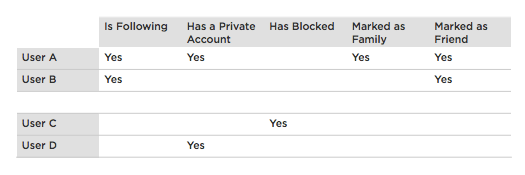In part one of Social Models in Online Software, I outlined the kinds of relationships we can infer on the Web and within online communities. In part two I discussed the characteristics of online groups and 2-way (or symmetrical) connections. In this post, I’ll provide an overview of how 1-way asymmetrical relationships are commonly modeled in online software.
Asymmetrical/1-way/fan/follow
As implied by their name, 1-way social relationships only have to be declared by one side. As a result, they are easier to establish quickly since no reciprocal action is required. In other words, someone can set up a 1-way relationship without waiting for confirmation from the other party (confirmation of a relationship is required in 2-way connections).
This makes 1-way connections a good fit for staying connected with interests like brands, celebrities, events, and more (as evidenced by the use of 1-way relationships in Twitter and Facebook fan pages). When popular, these kinds of entities can’t pay attention to everyone who wants to pay attention to them. Asymmetrical 1-way relationships mean they don’t have to –the number of people following a popular entity can be much bigger than the number they follow.
1-way connections also support multiple relationship structures. While the act of following a person or interest may seem simple on the surface, it can actually get quite complex. Consider the different relationships two people (A and B) can have in a 1-way system:
- A follows B (one direction)
- B follows A (other direction)
- A follows B, B follows A (mutual)
- A nor B follow each other
- A blocks B (can’t follow)
- A has private account, allows B to follow (permissioned follow)
1-way relationships can also be categorized and associated with content sharing or permissions. In Flickr’s social relationship model:
- A can follow B
- A can optionally mark B as friend, family, or both
- Friend and family categories enable different permissions (restricted photo sharing)
- B does not have to reciprocate the relationship to see permissioned content (unlike a 2-way relationship)
1-way relationships can also be permission-based (private) by default like they are on Yahoo! Messenger.
- When A sends B a request, first B accepts, then A has to accept as well
- Once permission is given, there is no way to revoke it (unlike 2-way relationships). Users can only appear offline or ignore/block unwanted relationships that they previously agreed to.
- The two 1-way relationships are independent but may be perceived by users as 2-way relationships because of the mutual permissioning required to set up the relationship
As you can see, 1-way connections enable a diverse range of social relationships. Consider the relationships between user A and B compared to the one between user C and D in the table below. Both use the 1-way model but the amount of information we know about the relationship itself is quite different.

This is powerful but potentially difficult. When asked to classify our relationships with people, most of us jump to the context in which we know them: high school, family, work colleagues, and so on. Yet most of our real world relationships are complex. For example, two people can work together, be friends, and also see each other at family events every now and then. We manage this complexity in the real world without much trouble. But when translated to the permissions and categories of 1-way relationships online, things can get confusing.
Some interesting data points on the 1-way connections in Twitter:
- 10% of users account for 90% of production
- 50% have not updated status in past 7 days
- 55% are not following anyone
- 52% have no followers
Coming Next…
In the next article about my Impact of Social Models talk, I’ll examine potential differences in contribution that stem from the use of distinct social models.